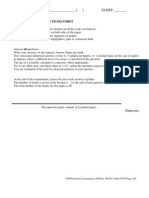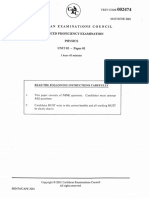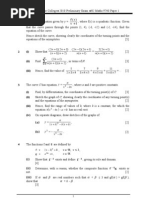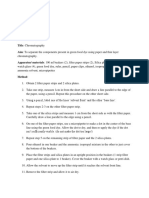Binomial Expansions
Binomial Expansions
Uploaded by
ShafiqueDeshongCopyright:
Available Formats
Binomial Expansions
Binomial Expansions
Uploaded by
ShafiqueDeshongOriginal Description:
Copyright
Available Formats
Share this document
Did you find this document useful?
Is this content inappropriate?
Copyright:
Available Formats
Binomial Expansions
Binomial Expansions
Uploaded by
ShafiqueDeshongCopyright:
Available Formats
BINOMIAL EXPANSIONS
YEA QUESTION
R
201 4(a) The function f is defined as 6
f ( x )= 4 x3 + 4 x+ 1for1< x <1.
6
1
(i) Show that f ( x )=( 1+2 x )3 .
The series expansion of ( 1+ x )k is given as
k ( k1 ) x 2 k ( k 1 )( k 2 ) x3 k ( k1 ) ( k 2 )( k3 ) x 4
1+kx + + + +
2! 3! 4!
where k R and1< x <1.
(ii) Determine the series expansion of f up to and including
4
the term in x .
(iii) Hence, approximate f ( 0.4 ) correct to 2 decimal places.
201 4(a)(i) For the binomial expansion of ( 2 x +3 )20 , show that the ratio of the
4 3
term in x 6 to the term in x 7 is .
4x
(ii)a) Determine the FIRST THREE terms of the binomial expansion of
( 1+2 x )10 .
b) Hence, obtain an estimate for ( 1.01 )10 .
n! n! ( n+1 ) !
(b) Show that + = .
( n1 ) ! r ! ( nr +1 ) ! ( r1 ) ! ( nr+ 1 ) ! r !
201 4(a)(i) Obtain the binomial expansion of 4 { 1+ x + 4 ( 1x ) up to the term
3 containing x 2 .
1
(ii) Hence, by letting x= , compute an approximation of 4 17+ 4 15
16
to four decimal places.
(b) Show that the coefficient of the x 5 term of the product ( x+ 2 )5 ( x2 )4
is 96.
201
2 4(a)(i) Express (nr ) in terms of factorials.
(ii) Hence, show that (nr )=(nr
n
) .
8
3
(iii) Find the coefficient of x4 in ( x 2
x ) .
Prepared by Dawn Scott January 2017Page 1
(iv) Using the identity ( 1+ x )2 n =( 1+ x )n ( 1+ x )n , show that
n
2 n =C 2+C 2 +C 2+ +C2 +C 2 ,
( )
n
0 1 2 n1 n where
C r= n
()
r
.
201 3(b)(i) Find the constants A and B such that
1
23 x A B
= +
( 1x )( 12 x ) 1x 12 x
(ii) Obtain the first FOUR non-zero terms of the expansion of each
( 1x )1 and ( 12 x )1 as power series of x in ascending order.
(ii) Find (a) the range of values of x for which the series expansion of
23 x
is valid.
( 1x )( 12 x )
(b) the coefficient of x n in (iii)(a) above.
5(a) (nr) is defined as the number of ways of selecting r distinct objects
from a given set of n distinct objects. From the definition, show that,
(i) (nr)=(nrn )
(ii) (n+1r )=(nr)+( r1n )
(iii) Hence, prove that
(( ) ( )) (( ) ( ))
8+ 8 8 + 8
6 5 3 2
is a perfect square.
201 3(c)(i) Use the binomial theorem to expand ( 1+2 x )1 /2 as far as the term in
0
x 3 , stating the values of x for which the expansion is valid.
x 1
(ii) Prove that = ( 1+ x 1+ 2 x ) for x> 0.
1+ x + 1+2 x x
(iii) Hence, or otherwise, show that, if x is small so that the term in
x 3 and higher powers of x can be neglected, the expansion in (c)
1
(ii) above is approximately equal to x ( 1x ) .
2
Prepared by Dawn Scott January 2017Page 2
n n
4(a)(i) By expressing Cr and C r1
in terms of factorials, prove that
n n n+1
C r + Cr 1=
Cr .
200 n N such that 5 nC2 2 C2 .
n2
9 4(a)(i) Find
1 2 x 1 px
5 4
is 26. Find
2
(ii) The coefficient of x in the expansion of
the possible values of the real number p.
200 1 x
12
8 4(b)(i) Use the binomial theorem or Maclaurins theorem to expand
3
in powers of x as far as the term in x , stating the values of x for which
the expansion is valid.
1 x
1
2
.
(ii) Obtain a similar expansion for
3
(iii) Prove that if x is so small that x and higher powers of x can be
neglected, then
1 x 1
1 x x2 .
1 x 2
1
, x
(iv) Hence, by taking 17 show, without using calculators or tables,
1635
TNT .
that 2 is approximately equal to 1156
15
6
x 3 .
2
4(b) Find the term independent of x in the expansion of x
(c) Use the binomial theorem to find the difference between
210 and 2.002
10
correct to 5 decimal places.
200 10
5
2 x 3 .
2
7
8. Find the term independent of x in the expansion of x
n!
n
Ck
k ! n k !
9(a) Use the fact that to express, in terms of factorials,
u of x in the expansion of 1 x .
n 2n
(i) the coefficient of
v of x n in the expansion of 1 x
2 n 1
.
(ii) the coefficient of
(b) Hence, show that u 2v.
200 5 4
6
x 2
C2
2
C3 , x 3,
8. If
(a) show that x 5 x 14 0.
2
(b) find x.
1 ux 2 x
3
in powers of x up to the term in x 2 , u R.
9(a) Expand
Prepared by Dawn Scott January 2017Page 3
2
(b) Given that the coefficient of the term in x is zero, find the value of u.
200 Ck and nCk 1 , for n k 1,
n
5 8(a) Express the binomial coefficients in terms of
factorials.
(b) Hence, show that
Ck nCn k
n
(i)
n 1
n
Ck nCk 1 Ck
(ii)
7 11
9. The coefficient of x is sixteen times the coefficient of x in the
a x
18
. Ck nCn k
n
expansion of Given that , find the possible value(s) of
the real constant a.
3(c) By substituting suitable values of x on both sides of the expansion of
Cx,
n
1 x
n
n
r
r
r 0 show that
C 2
n
n n
r
(i) r 0
C 1 0
n
n r
r
(ii) r 0
200 10
5
2 x 3 .
2
4
6. Find the term independent of x in the expansion of x
1 ax 1 6 x 16 x2 ...
n
9. If a and n.
find the values of the constants
2
4(b) Given that the coefficient of x is zero in the binomial expansion of
1 ax 1 2 x
5
, 3
find the value of a and the coefficient of x .
200 8
1
2x .
3
3
9. Find the term independent of x in the expansion of x
4(c)(i) Write down and simplify as far as possible, the FIRST THREE terms in
1 ux 2 x
4
.
the expansion of
2
(ii) Given that the coefficient of x is 0, find
(a) the value of a
(b) the coefficient of x.
200 x5 in the expansion of 1 5 x
8
2 8. The coefficient of is equal to the coefficient of
Prepared by Dawn Scott January 2017Page 4
x 4 in the expansion of a 5 x . Find the value of a.
7
200 9
3x2 1
1
2 3x
8. Without expanding completely, find
(i) the term independent of x
6
(ii) the coefficient of x
200 1 3x 1 2 x
9
6
0 7. Find the coefficient of x in the expansion of as a series of
ascending powers of x.
199 6
8. Calculate the value of k if the coefficient of x in the expansion of
9
4 kx
10
is 840.
Prepared by Dawn Scott January 2017Page 5
You might also like
- Xi - Maths - Chapter 11 - Hyperbolic Functions (156-165)Document10 pagesXi - Maths - Chapter 11 - Hyperbolic Functions (156-165)Dinesh BabuNo ratings yet
- 1 - 10 Mean Median ModeDocument2 pages1 - 10 Mean Median Modecristina gomezNo ratings yet
- Numerical RenaissanceDocument767 pagesNumerical RenaissancepabsramsNo ratings yet
- CH 8 SolDocument47 pagesCH 8 SolBSNo ratings yet
- Binomial TheoremDocument3 pagesBinomial TheoremKelvin LimNo ratings yet
- Class XI Mathematics Chapter Notes Linear Inequalities DefinitionsDocument6 pagesClass XI Mathematics Chapter Notes Linear Inequalities DefinitionsAniruddh MaheshwariNo ratings yet
- ACSIAM1Document3 pagesACSIAM1JASON_INGHAMNo ratings yet
- Sample U2Document20 pagesSample U2Lashaun Earlette LuggNo ratings yet
- Read These Instructions First: NAME: - CLASSDocument6 pagesRead These Instructions First: NAME: - CLASSJASON_INGHAMNo ratings yet
- ACS Barker 2007 AMaths P1Document6 pagesACS Barker 2007 AMaths P1MINGHUI86No ratings yet
- 3D Analytical GeometryDocument3 pages3D Analytical GeometryMaths Home Work 123100% (1)
- Cape Pure Mathematics Unit 2module 2: Sequences, Series and ApproximationsDocument39 pagesCape Pure Mathematics Unit 2module 2: Sequences, Series and ApproximationsCarlon BairdNo ratings yet
- Cape Physics 2001 U2 p1Document18 pagesCape Physics 2001 U2 p1SashidaeNo ratings yet
- Roots of Complex NumbersDocument3 pagesRoots of Complex NumbersntimalsinaNo ratings yet
- MM-Limits and ContinuityDocument22 pagesMM-Limits and ContinuityKim Say Chun / Sc.KIMNo ratings yet
- Chapter 2. Techniques of IntegrationDocument36 pagesChapter 2. Techniques of IntegrationNyx ChaosNo ratings yet
- Cape Mathematics Unit 2 Practice Mod 1Document3 pagesCape Mathematics Unit 2 Practice Mod 1Danel50% (2)
- Methodist Girls' School: Preliminary Examination 2022 Secondary 4Document20 pagesMethodist Girls' School: Preliminary Examination 2022 Secondary 4Magdalene ChoNo ratings yet
- 2023 Pss 4e Am Prelim p2 MsDocument19 pages2023 Pss 4e Am Prelim p2 MsJinzhi ZhengNo ratings yet
- MatrixDocument15 pagesMatrixLAWAND MUSLEMNo ratings yet
- CAPE Pure Math P1 2008-2020Document117 pagesCAPE Pure Math P1 2008-2020Leah CassieNo ratings yet
- 2023 Pss 4e Am Prelim p1 MsDocument21 pages2023 Pss 4e Am Prelim p1 MsJinzhi ZhengNo ratings yet
- P1 Chp12 DifferentiationDocument56 pagesP1 Chp12 DifferentiationLOLNo ratings yet
- Inverse Trigonometry DoneDocument4 pagesInverse Trigonometry Donesourabh rajNo ratings yet
- 3-Geometrical Representation of Complex NumbersDocument12 pages3-Geometrical Representation of Complex Numbersprasad madushankaNo ratings yet
- Matrix ApplicationDocument21 pagesMatrix ApplicationMahjabin Zerin RahmanNo ratings yet
- Circle Exercise For 12Document7 pagesCircle Exercise For 12Jibran Siddiqui100% (1)
- S s-11 Sense of Variation of A FunctionDocument3 pagesS s-11 Sense of Variation of A Functionapi-253679034100% (1)
- PC FUNCTIONS End Behavior of Polynomial and Rational FunctioDocument16 pagesPC FUNCTIONS End Behavior of Polynomial and Rational FunctioHector R.No ratings yet
- CH4 1 PDFDocument67 pagesCH4 1 PDFSarahJavaidNo ratings yet
- Em 18 Equilibrium of A ParticleDocument2 pagesEm 18 Equilibrium of A ParticleFattihi EkhmalNo ratings yet
- Differentiation Question Bank Maths LDocument60 pagesDifferentiation Question Bank Maths LUmair Khan MarwatNo ratings yet
- CSEC Mathematics May 2007Document15 pagesCSEC Mathematics May 2007raynardowwwNo ratings yet
- Sec3classtest - Preparation of Salts - Marking SchemeDocument4 pagesSec3classtest - Preparation of Salts - Marking Schemescientia est potentiaNo ratings yet
- Applications of Differentiation PDFDocument9 pagesApplications of Differentiation PDFKeri-ann MillarNo ratings yet
- The Real Number SystemDocument11 pagesThe Real Number SystemKAPIL SHARMANo ratings yet
- Pure Math Cape Unit 1 Parametric DifferentiationDocument8 pagesPure Math Cape Unit 1 Parametric DifferentiationHugh IngramNo ratings yet
- B.SC - Semester Chemistry - Syllabus ToDocument23 pagesB.SC - Semester Chemistry - Syllabus ToMan Deep SinghNo ratings yet
- Pure Math Cape Unit 1 LogarithmsDocument3 pagesPure Math Cape Unit 1 LogarithmsHugh IngramNo ratings yet
- FALLSEM2019-20 MAT1011 ETH VL2019201005249 Reference Material II 19-Sep-2019 Solved-Problems Double-and-Triple-Integrals-2 PDFDocument18 pagesFALLSEM2019-20 MAT1011 ETH VL2019201005249 Reference Material II 19-Sep-2019 Solved-Problems Double-and-Triple-Integrals-2 PDFabhist chuhan100% (1)
- Integral Calculus: Solved ExercisesDocument14 pagesIntegral Calculus: Solved Exercises林子揚No ratings yet
- Complex NumbersDocument24 pagesComplex Numbersmatthew chombaNo ratings yet
- Catholic High School Preliminary Examinations (3) Secondary Four Additional Mathematics PaperDocument8 pagesCatholic High School Preliminary Examinations (3) Secondary Four Additional Mathematics PaperJASON_INGHAMNo ratings yet
- Gamma DistributionDocument30 pagesGamma DistributionshardultagalpallewarNo ratings yet
- MatricesDocument8 pagesMatricesMoses SikaongaNo ratings yet
- IntegrationDocument7 pagesIntegrationapi-516387140No ratings yet
- Ad Math Sba 5.1 (JMM)Document10 pagesAd Math Sba 5.1 (JMM)JANE BALBOSA MOHAMMEDNo ratings yet
- O LVL Chemistry Hwa Chong Prelim 2010 PDFDocument39 pagesO LVL Chemistry Hwa Chong Prelim 2010 PDFSONo ratings yet
- 08 Matrices and Vector Analysis (Lesson 08)Document14 pages08 Matrices and Vector Analysis (Lesson 08)Anowar AnuNo ratings yet
- 3 - Roots of Complex NumbersDocument10 pages3 - Roots of Complex Numbersdfgb fbnNo ratings yet
- CAPE Biology 2010 U2 P2 PDFDocument19 pagesCAPE Biology 2010 U2 P2 PDFMarikaNo ratings yet
- Introduction To ProbabilityDocument12 pagesIntroduction To ProbabilityAriel Raye RicaNo ratings yet
- Chapter 5 INTRODUCTION TO TRIGONOMETRYDocument5 pagesChapter 5 INTRODUCTION TO TRIGONOMETRYLiyakath AliNo ratings yet
- W7 Second Order Linear Differential Equation Part 1 - ModuleDocument5 pagesW7 Second Order Linear Differential Equation Part 1 - ModuleRaison MichNo ratings yet
- CAPE 2016 SBA Manual For PrincipalsDocument102 pagesCAPE 2016 SBA Manual For PrincipalsTiffany FordeNo ratings yet
- FunctionsDocument1 pageFunctionsLoo Siaw ChoonNo ratings yet
- Chapter 15 Difference EquationsDocument10 pagesChapter 15 Difference EquationsSay MacedoniaNo ratings yet
- Maclaurin and Taylors SeriesDocument2 pagesMaclaurin and Taylors SeriesdssrwrtgwtgNo ratings yet
- RVHS 9758 H2 Promo 2022Document5 pagesRVHS 9758 H2 Promo 2022txjun41No ratings yet
- 2010 Yjc H2ma Prelim p1Document4 pages2010 Yjc H2ma Prelim p1cjcsucksNo ratings yet
- Math Past Papers - Totoz CompilationDocument78 pagesMath Past Papers - Totoz CompilationFrank SichimbaNo ratings yet
- N.B: Answer Six Questions, Taking Three From Each SectionDocument2 pagesN.B: Answer Six Questions, Taking Three From Each SectionRakib HasanNo ratings yet
- Lab 13 ChromatographyDocument2 pagesLab 13 ChromatographyShafiqueDeshongNo ratings yet
- Diagram Showing Basic Test Configuration: Table 1 Showing Measured and Expected Resistor ValuesDocument2 pagesDiagram Showing Basic Test Configuration: Table 1 Showing Measured and Expected Resistor ValuesShafiqueDeshongNo ratings yet
- Answers To Revision Questions: Module 3 Chapters 11-13 (Page 154)Document2 pagesAnswers To Revision Questions: Module 3 Chapters 11-13 (Page 154)ShafiqueDeshongNo ratings yet
- Id Number Weight (KG) Height (M) Waist (M) Resting Blood Pressure (MMHG) Systolic DiastolicDocument2 pagesId Number Weight (KG) Height (M) Waist (M) Resting Blood Pressure (MMHG) Systolic DiastolicShafiqueDeshongNo ratings yet
- CAPE Physics MCQ - Answer KeyDocument54 pagesCAPE Physics MCQ - Answer KeyShafiqueDeshongNo ratings yet
- Answers To Revision and Practice Exam QuestionsDocument1 pageAnswers To Revision and Practice Exam QuestionsShafiqueDeshongNo ratings yet
- TAP 514-1: Measuring Half Life of Protactinium: Radioactive SourcesDocument5 pagesTAP 514-1: Measuring Half Life of Protactinium: Radioactive SourcesShafiqueDeshongNo ratings yet
- Curriculum Vitae: Personal DetailsDocument2 pagesCurriculum Vitae: Personal DetailsShafiqueDeshongNo ratings yet
- The Collision CoursesDocument5 pagesThe Collision CoursesShafiqueDeshongNo ratings yet
- Logic Gate Lab Report: Deep Dhillon January 12, 2015Document14 pagesLogic Gate Lab Report: Deep Dhillon January 12, 2015ShafiqueDeshongNo ratings yet
- Mom WorkDocument1 pageMom WorkShafiqueDeshongNo ratings yet
- Limiting Factors: J. J. Marshall-Thompson CAPE Biology Bioenergetics 19 September, 2016Document12 pagesLimiting Factors: J. J. Marshall-Thompson CAPE Biology Bioenergetics 19 September, 2016ShafiqueDeshongNo ratings yet
- NumbersDocument6 pagesNumbersAdarsh SasiNo ratings yet
- Find Each Indicated Product: 2s (S - 4) (X + 9) (X - 2) (3 - 5m)Document12 pagesFind Each Indicated Product: 2s (S - 4) (X + 9) (X - 2) (3 - 5m)Maida Castillejo DoniegoNo ratings yet
- Problem Situation - Mathematical ThinkingDocument9 pagesProblem Situation - Mathematical ThinkingErick Aguilera HernándezNo ratings yet
- Cambridge IGCSE: Additional Mathematics 0606/13Document16 pagesCambridge IGCSE: Additional Mathematics 0606/13hang yinNo ratings yet
- Teoria Grupos Quantum MechanicsDocument357 pagesTeoria Grupos Quantum MechanicsLuisgarciaBerlanga100% (5)
- MAA SL-HL PlanDocument3 pagesMAA SL-HL PlanMIhaela CorcheNo ratings yet
- Functions and Graphs NotesDocument3 pagesFunctions and Graphs Notessyedstrokes88No ratings yet
- Mat 1001Document3 pagesMat 1001Taran MamidalaNo ratings yet
- Floating-Point Inverse Square Root Algorithm Based On Taylor-Series ExpansionDocument5 pagesFloating-Point Inverse Square Root Algorithm Based On Taylor-Series Expansionpradipta.sarkarNo ratings yet
- List of Mathematical Symbols: Symbol Symbol Explanation ExamplesDocument16 pagesList of Mathematical Symbols: Symbol Symbol Explanation ExamplesKostas LaftsidisNo ratings yet
- Math 10 Summative TestDocument2 pagesMath 10 Summative TestRowena BenigaNo ratings yet
- Lecture 2 - Description (00-12-01)Document50 pagesLecture 2 - Description (00-12-01)MahdiNo ratings yet
- Ma211: Advanced Calculus Assignment 1: Semester 1, 2023 TOTAL: 70 MarksDocument2 pagesMa211: Advanced Calculus Assignment 1: Semester 1, 2023 TOTAL: 70 MarksKavita DeviNo ratings yet
- 4.93 MSC Physics Sem I, II, III, IV PDFDocument98 pages4.93 MSC Physics Sem I, II, III, IV PDFashwiniNo ratings yet
- DR Nazir A. Zafar Advanced Algorithms Analysis and DesignDocument40 pagesDR Nazir A. Zafar Advanced Algorithms Analysis and DesignMrDj KhanNo ratings yet
- Chapter 4 Utility Maximization and ChoiceDocument50 pagesChapter 4 Utility Maximization and ChoiceDelmisVasquezMendoza100% (1)
- MEREDocument5 pagesMEREMario SánchezNo ratings yet
- NdaDocument27 pagesNdaVaibhav DubeyNo ratings yet
- PCS Algebra I Quiz 4 Chapter Review KEYDocument1 pagePCS Algebra I Quiz 4 Chapter Review KEYTim Ricchuiti100% (1)
- Numerical MethodsDocument2 pagesNumerical MethodsRavi ParkheNo ratings yet
- Jacobi MethodDocument11 pagesJacobi MethodSyed Saad Wasti100% (1)
- Lesson 7-Differentiation of Trigonometric FunctionsDocument16 pagesLesson 7-Differentiation of Trigonometric FunctionsKay SalazarNo ratings yet
- Advanced Calculus MTH 312Document68 pagesAdvanced Calculus MTH 312Samson Mide Folorunsho100% (1)
- Gamma FunctionDocument18 pagesGamma FunctionNassim BOUKALNo ratings yet
- MECN3036 FormulaSheetDocument2 pagesMECN3036 FormulaSheetMuaaz MoosaNo ratings yet
- BesintDocument457 pagesBesintccNo ratings yet
- Multiple Choice Test Bank Questions No Feedback - Chapter 1Document8 pagesMultiple Choice Test Bank Questions No Feedback - Chapter 1Chekralla HannaNo ratings yet
- Experiment # 3 Mathematical Modelling and Simulation of Mechanical SystemsDocument7 pagesExperiment # 3 Mathematical Modelling and Simulation of Mechanical SystemsFahad AneebNo ratings yet





































































































